Diversity, Collegiality Said to Rise as Priorities
SPJ Picks First Black Woman as President-to-Be
Homepage photo: New York Times building (Credit: New York Times Co.)
Journal-isms Roundtable photos by Sharon Farmer/sfphotoworks
The Journal-isms Roundtable drew 66 people participating by Zoom, and another 63 having watched on Facebook by Oct. 29, and 82 others viewing on YouTube by then.
Diversity, Collegiality Said to Rise as Priorities
Dean Baquet, for eight years the executive editor of The New York Times, responded to a question about declining trust in media. He acknowledged that “in the days when we were just all print, we didn’t tell people how we made decisions. We didn’t tell people who our reporters were, what their backgrounds were.
“We didn’t own up to our mistakes. We just didn’t talk about this stuff. We were frankly a little arrogant. . . . We weren’t very diverse. I think in the last few years we understand that that’s wrong.”
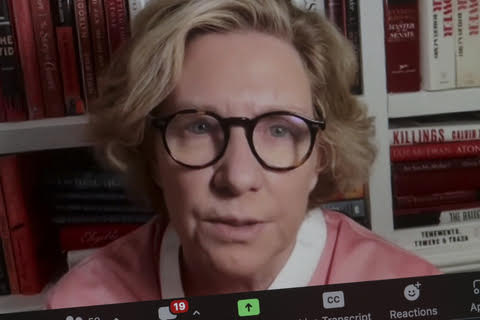 Carolyn Ryan (pictured), co-managing editor of the Times, pointed to the Times’ coverage of the shooting at the gay Pulse nightclub in Orlando in 2016, in which 49 people died. “I think because I’m gay, the poignancy of seeing these parents look for their kids, and the fact that they had this loving relationship with this generation of gay people in a way that wasn’t the case when I was born, and wasn’t the case in that earlier generation that Dean was able to point to in Louisiana . . . we were able to bring something that felt like a different perspective.”
Carolyn Ryan (pictured), co-managing editor of the Times, pointed to the Times’ coverage of the shooting at the gay Pulse nightclub in Orlando in 2016, in which 49 people died. “I think because I’m gay, the poignancy of seeing these parents look for their kids, and the fact that they had this loving relationship with this generation of gay people in a way that wasn’t the case when I was born, and wasn’t the case in that earlier generation that Dean was able to point to in Louisiana . . . we were able to bring something that felt like a different perspective.”
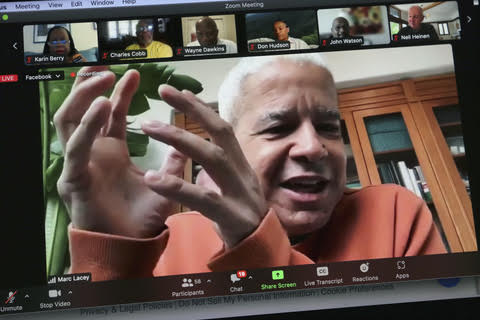 Marc Lacey (pictured), like Ryan a new managing editor, was asked whether progress on diversity will be a factor in editors’ compensation as it elevates those concerns. Lacey said, “The answer is yes. I think there’s been a lot of talk about doing this in the past, but we’re baking it into our system now.”
Marc Lacey (pictured), like Ryan a new managing editor, was asked whether progress on diversity will be a factor in editors’ compensation as it elevates those concerns. Lacey said, “The answer is yes. I think there’s been a lot of talk about doing this in the past, but we’re baking it into our system now.”
Lacey also said, “We have to spend some time really on the details of race coverage. I mean I notice” racial identifications “a whole lot. I think it’s less now, but it still appears in our stories that we will identify when someone is Black. . . . And then I look and then there’s the name of someone and no race of that person. . . . So I was able to send a note to the reporter and editor saying, ‘I noticed you identified this one Black person by race. Could you please identify everybody in the story by race?’ . . .
“I was doing that simply to make the point that we’re not writing for white people. We’re not . . . We’re writing for a diverse multicultural international audience, and that means that some of our conventions of old have to be rethought. . . .”
The three editors were speaking at the Journal-isms Roundtable held Oct. 16, with 66 people participating by Zoom, another 63 having watched on Facebook by Oct. 29, and 82 others viewing on YouTube by that date. You can watch here or view the embedded version above.
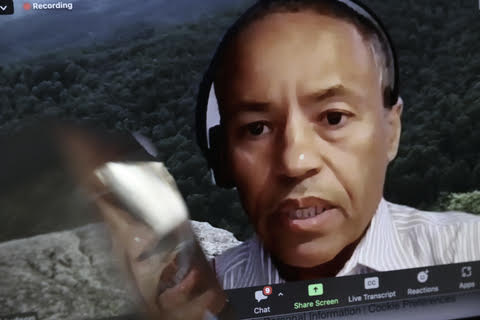 Three other top editors were present: Don Hudson (pictured), managing editor of Newsday who will assume the top job shortly; Kevin Merida of the Los Angeles Times and Maria Reeve of the Houston Chronicle. We toasted Hudson, who said, “I try to tell folks that we should be thinking like everyone else. We should be thinking like The New York Times, Washington Post, the L.A. Times, and that’s the way we should be thinking on a daily basis because that’s the way Newsday can be, will be and should be.” The other editors praised him, with Ryan saying Newsday “consistently punches above its weight.”
Three other top editors were present: Don Hudson (pictured), managing editor of Newsday who will assume the top job shortly; Kevin Merida of the Los Angeles Times and Maria Reeve of the Houston Chronicle. We toasted Hudson, who said, “I try to tell folks that we should be thinking like everyone else. We should be thinking like The New York Times, Washington Post, the L.A. Times, and that’s the way we should be thinking on a daily basis because that’s the way Newsday can be, will be and should be.” The other editors praised him, with Ryan saying Newsday “consistently punches above its weight.”
If there was a theme in the discussion, it was that this is not your parents’ New York Times.
“The New York Times is no longer a newspaper, it really is this juggernaut of a news organization that has a daily podcast, that is 24 hours, that is producing this digital report,” Lacey said. “We’re in video, we’re in live events — it really is this sprawling and sprawling news organization.”
Added Ryan, “When I came to the Times, which was ’07, I think there were about 1,200 employees in the newsroom and now we’re coming up on 2,000, so the complexities of running the place and the many kinds of formats from audio to TV to traditional text and . . . visual investigations has just expanded dramatically. . . .”
Moreover, the newsroom culture is changing. “We did a couple things after the murder of George Floyd,” Ryan added.
“One was look companywide at a whole range of diversity and inclusion issues.
“And then we did very newsroom-specific analysis and kind of clear-eyed assessment of where we were.
“And essentially, what we found is that The New York Times in a lot of ways was a place that was very hard to navigate, was still very opaque. . . . In some ways your advancement seemed to be based on who you knew and relationships, and that was a problem for a lot of people who came to the Times.
“But it was especially acute for people of color.
“And so we set out to change a whole bunch of things.
“We set up a Culture and Careers department. We set up individual goals, diversity goals for each desk.
“But most meaningfully to me, we focused on Black and Latino leadership.”
Said Baquet, “I made a little list to myself of the major news departments that are now run by people of color.
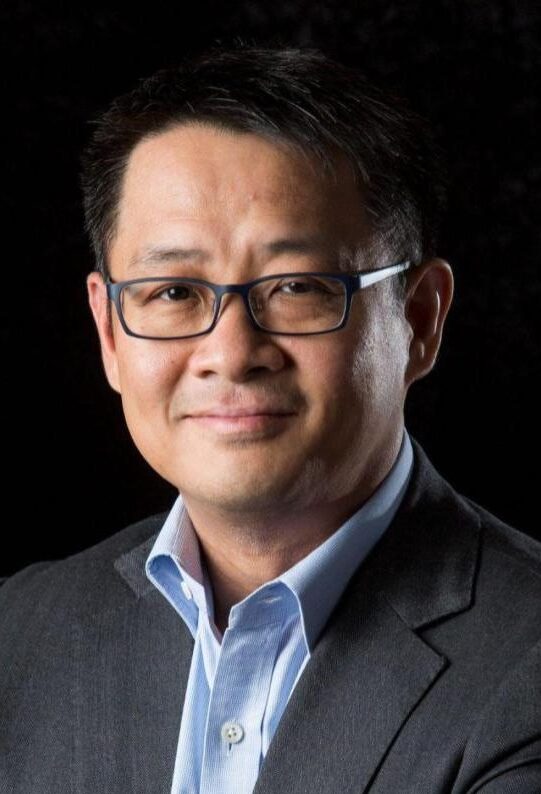 “The national desk [Jia Lynn Yang]. The metro desk [Nestor Ramos]. The Books desk [Gilbert Cruz] , the international desk [Phil Pan, pictured], the real estate desk [Nikita Stewart], the sports desk [Randy Archibold].
“The national desk [Jia Lynn Yang]. The metro desk [Nestor Ramos]. The Books desk [Gilbert Cruz] , the international desk [Phil Pan, pictured], the real estate desk [Nikita Stewart], the sports desk [Randy Archibold].
“It’s a much more — I mean . . . I don’t think anybody who works for The New York Times who is on this call would deny that we have issues, of course we do.
“But it’s a much more diverse leadership team than it was even five years ago.”
The same is true at Newsday, Hudson interjected. “If you look at our Page 2 of the people in positions, with a seat at the table, eight of the 15 are people of color.”
Baquet (pictured) said his interest in diversity helped lead to his current assignment, leading the Times’ new Local Investigations Fellowship program.
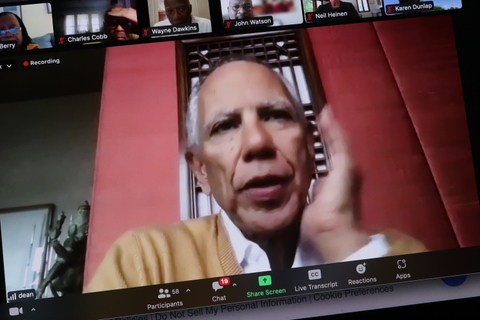 “I was about to leave the Times. You know . . . when you hit 65 years, the tradition is the executive editor steps down. I’ve been editor for eight years, which shockingly is like the second- or third-longest run in the history of the paper.
“I was about to leave the Times. You know . . . when you hit 65 years, the tradition is the executive editor steps down. I’ve been editor for eight years, which shockingly is like the second- or third-longest run in the history of the paper.
“When the publisher came to me and said, ‘Look, we don’t really want you to leave and we have this idea. You care deeply about investigative reporting; you also care deeply about diversity. Can we come up with something that marries those two?
“So, essentially what we’re going to do is, we’re gonna pick a group of fellows every year to do investigative projects. Probably in the first year, it’ll be, say, 10, but I hope it grows over time, and people will pitch investigative stories to us. We will pay their salaries. We will edit their stories. We’ll publish them in The New York Times and wherever local news organizations they’re from.
“Freelancers can apply, people who are not connected to a news organization can can apply. . . . I took a month off, so what I’ve been doing in the months since is visiting some newsrooms talking to people just to sort of get a sense of what people want from this kind of program.”
Yes, Spanish-language news organizations and the Black press are eligible, Baquet said in response to questions.
To Baquet’s point that newspapers need to be more transparent, Ryan noted that the Times has created a “Trust Team” to “take on the challenge of developing innovative ways of deepening our audience’s trust in our mission and in the credibility of our journalism, no matter where it is encountered,” in the words of a news release.
Ryan continued, “You think of New York Times readers as pretty sophisticated. We found out they just had no idea about some basic things, from, you know, the differences between a column and an article, or how we get our information. . . . Basically, what they’re trying to do mainly on the website is explain how we do our journalism.
“It’s almost like a media literacy course in real time: how we got this information, when we can . . . including the data, the number of people we talked to; but you would be amazed at what people both don’t know and kind of assume wrongly about journalism and how . . . they do their work.”
As has been cited in news reports, the Times is in the midst of slow-moving News Guild negotiations, and like other news organizations, is hoping to persuade its journalists to return to the newsroom after having worked remotely during the COVID pandemic. “They just filmed a movie in the New York Times newsroom,” Baquet said. The newsroom “was so empty they had to hire actors because otherwise there was nobody there.”
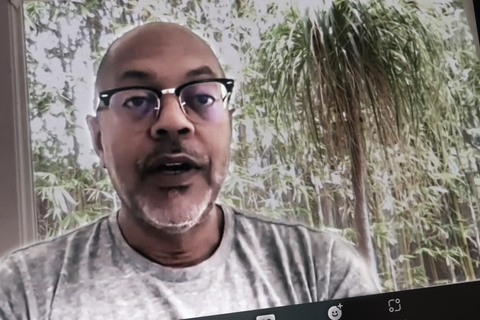 Merida (pictured) said, “The future of work is a whole area of coverage. . . . It’s a whole new topic, you know it’s not gonna be the same . . . and all companies are grappling with it. I do think some of the serendipity is missing, of just being together and being able to have that kind of organic quality of walking over and ideas flowing and seeing things, you know, being at the hub of the news . . . and so we’re missing that.” We “don’t want to lose that forever.”
Merida (pictured) said, “The future of work is a whole area of coverage. . . . It’s a whole new topic, you know it’s not gonna be the same . . . and all companies are grappling with it. I do think some of the serendipity is missing, of just being together and being able to have that kind of organic quality of walking over and ideas flowing and seeing things, you know, being at the hub of the news . . . and so we’re missing that.” We “don’t want to lose that forever.”
Baquet is the only person to have been top editor at both the Los Angeles Times and New York Times, and he was the first African American in the job in both places. He and Merida, the second Black editor at the L.A. Times, bantered about how much Baquet missed the palm trees.
Baquet was asked his reaction to a story told by Reginald Hudlin, who has directed a new documentary about the late pioneering actor Sidney Poitier.
Oprah Winfrey, who produced the film, told of meeting Poitier, whom she idolized, years ago at a party. She told him that some in the Black community were attacking her as not “Black enough,” and asked what Poitier thought. “It’s always a challenge when you’re carrying other people’s dreams,” Poitier said. “And that’s what you’re carrying, our dreams.”
“My reaction is he’s a lot more eloquent than I am, and a better actor,” “Baquet said of Poitier.
“I thought a lot about what it meant to be the first Black editor not only of The New York Times but the L.A. Times . . . and there’s no question, of course. . . . Who you are affects how you edit. It just does, and it should. It should. I’ve also felt really proud of the fact that in each case I was the first Black editor of those news organizations. . . .
“I had a great lunch once with a young Black reporter at The New York Times who I’d hired, who I disagreed with about something, and she taught me a lesson: It’s always good for somebody younger than you are to teach you the lesson — so I was trying to explain to her why I thought she was wrong. And she looked at me and she said, ‘Did you think that when you hired me and people like me, we would be exactly like you?’ And I thought, well that’s a great lesson. In fact — no — she shouldn’t be exactly like me. I should understand that she comes to the game with sort of a different generation, a different outlook.
“I should listen to her and understand the points where I’m wrong. I should hold on to the ones when I’m right, but I can’t be right all the time. But I guess to go back to the original question, there’s a lot of pressure. Don knows this too, and all of you who’ve run news organizations know this. There’s a lot of pressure period, and of course there’s always more pressure if you’re a leader who happens to be Black. There’s a whole lot more pressure.
“But I guess I would say that after a long run, if you add L.A. and New York together it’s like more than a decade, the tremendous pride and the influence you can have on these institutions outweighs any of the pressure.”
Other discussion points included the concept of “objectivity” [it “has come to be a cuss word, so I don’t even use it anymore,” Baquet said], the eliminated public editor position [“frankly, the original reason to have a public editor doesn’t quite hold anymore”], and Baquet’s belief that “one of the challenges for journalists today is how do we understand the presence of the open racism . . . that has come to exist in society now. Whether it’s different, whether it’s more.”
- New York Times Co.: Diversity and Inclusion
- New York Times Co.: The Times Invites Applicants to Two Newsroom Fellowship Programs
- Journal-isms: N.Y. Times to Overhaul Performance Evaluations (second item) (Oct. 16)
- New York Times Co.: The New York Times Company Adds 180,000 Digital Subscribers (Nov. 2)
- Howard Rambsy II and Kenton Rambsy, Public Books: How The “New York Times” Covers Black Writers (Oct. 12)
- Ben Smith, Semafor: Inside the Identity Crisis at the New York Times (Oct. 17, updated Oct. 18)
Outgoing President Rebecca Aguilar announces the election results Saturday at the Society of Professional Journalists meeting in Washington. “I had a great 14 months,” she told Journal-isms. “Very successful. We had 1500 new members, many more journalists of color and brought more sports journalists and Spanish language media into the SPJ fold.” (Credit: SPJ/YouTube)
SPJ Picks First Black Woman as President-to-Be
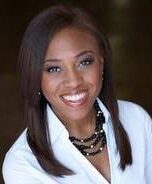 Ashanti Blaize-Hopkins (pictured), a journalism professor at Santa Monica College, was elected vice president of the Society of Professional Journalists, putting her on the ladder to become president, outgoing President Rebecca Aguilar announced Saturday at the SPJ’s national convention, “MediaFest22,” in Washington.
Ashanti Blaize-Hopkins (pictured), a journalism professor at Santa Monica College, was elected vice president of the Society of Professional Journalists, putting her on the ladder to become president, outgoing President Rebecca Aguilar announced Saturday at the SPJ’s national convention, “MediaFest22,” in Washington.
“I’m now the first Black woman ever to be elected Vice President of the Society of Professional Journalists,” Blaize-Hopkins tweeted. She describes herself as “an Emmy Award-winning journalist, producer, educator, author, higher education equity consultant and public relations expert with more than a decade of experience.”
“#RepresentationMatters and I’m proud to be a part of @spj_tweets, an organization that centers diversity, equity and inclusion,” she tweeted Oct 10. “If elected Vice President of #SPJ, I will continue this focus in the initiatives we plan, the programs we produce and the journalists we support.”
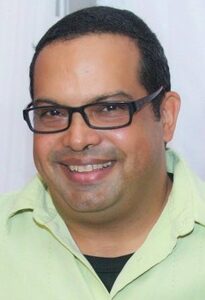 Blaize-Hopkins defeated Rafael Olmeda (pictured), a reporter for the South Florida Sun-Sentinel, who was an at-large representative to the SPJ board and is a former president of the National Association of Hispanic Journalists. She garnered 339 votes to Olmeda’s 263.
Blaize-Hopkins defeated Rafael Olmeda (pictured), a reporter for the South Florida Sun-Sentinel, who was an at-large representative to the SPJ board and is a former president of the National Association of Hispanic Journalists. She garnered 339 votes to Olmeda’s 263.
Olmeda told Journal-isms, “Borrowing a page from former vice president Dan Quayle, I told Ashanti that if she runs the board the way she ran the campaign, SPJ is in good hands.
“I made a lot of promises and commitments in my campaign. Having lost, my commitment remains to accomplish those goals anyway, without the title.”
Also elected were Israel Balderas, assistant professor of journalism at Elon University, winning 311 votes to Michael Koretsky’s 297 to become secretary-treasurer; Kevin Z. Smith, a former SPJ president (324 votes), and Adam Sennott, reporter at the Boston Globe (289 votes), as at-large directors, and Chris R. Vaccaro, Ginny McCabe, Nicole DeCriscio and McKenzie Romero as regional representatives. Their bios are here. Also in the race were Joe Radske, who garnered 244 votes, and Peter Szekely, 220 votes for the two-year at-large position.
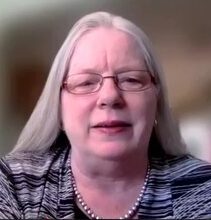 President-elect Claire Regan (pictured, by Sharon Farmer/sfphotoworks), contributing writer to the Staten Island (N.Y.) Advance and assistant professor of journalism at Wagner College, was sworn in as president.
President-elect Claire Regan (pictured, by Sharon Farmer/sfphotoworks), contributing writer to the Staten Island (N.Y.) Advance and assistant professor of journalism at Wagner College, was sworn in as president.
“Journalists need SPJ now more than ever for support and solidarity,” she said. “I promise to work hard to make every SPJ member feel valued and empowered.”
To subscribe at no cost, please send an email to journal-isms+subscribe@groups.io and say who you are.
Facebook users: “Like” “Richard Prince’s Journal-isms” on Facebook.
Follow Richard Prince on Twitter @princeeditor
Richard Prince’s Journal-isms originates from Washington. It began in print before most of us knew what the internet was, and it would like to be referred to as a “column.” Any views expressed in the column are those of the person or organization quoted and not those of any other entity. Send tips, comments and concerns to Richard Prince at journal-isms+owner@
View previous columns (after Feb. 13, 2016).
View previous columns (before Feb. 13, 2016)
-
-
- Diversity’s Greatest Hits, 2018 (Jan. 4, 2019)
- Book Notes: Is Taking a Knee Really All That? (Dec. 20, 2018)
- Book Notes: Challenging ’45’ and Proudly Telling the Story (Dec. 18, 2018)
- Book Notes: Get Down With the Legends! (Dec. 11, 2018)
- Journalist Richard Prince w/Joe Madison (Sirius XM, April 18, 2018) (podcast)
- Richard Prince (journalist) (Wikipedia entry)
- February 2018 Podcast: Richard “Dick” Prince on the need for newsroom diversity (Gabriel Greschler, Student Press Law Center, Feb. 26, 2018)
- Diversity’s Greatest Hits, 2017 — Where Will They Take Us in the Year Ahead?
- Book Notes: Best Sellers, Uncovered Treasures, Overlooked History (Dec. 19, 2017)
- An advocate for diversity in the media is still pressing for representation, (Courtland Milloy, Washington Post, Nov. 28, 2017)
- Morgan Global Journalism Review: Journal-isms Journeys On (Aug. 31, 2017)
- Diversity’s Greatest Hits, 2016
- Book Notes: 16 Writers Dish About ‘Chelle,’ the First Lady
- Book Notes: From Coretta to Barack, and in Search of the Godfather
- Journal-isms’ Richard Prince Wants Your Ideas (FishbowlDC, Feb. 26, 2016)
- “JOURNAL-ISMS” IS LATEST TO BEAR BRUNT OF INDUSTRY’S ECONOMIC WOES (Feb. 19, 2016)
- Richard Prince with Charlayne Hunter-Gault, “PBS NewsHour,” “What stagnant diversity means for America’s newsrooms” (Dec. 15, 2015)
- Book Notes: Journalists Follow Their Passions
- Book Notes: Journalists Who Rocked Their World
- Book Notes: Hands Up! Read This!
- Book Notes: New Cosby Bio Looks Like a Best-Seller
- Journo-diversity advocate turns attention to Ezra Klein project (Erik Wemple, Washington Post, March 5, 2014)
-
When you shop @AmazonSmile, Amazon will make a donation to Journal-Isms Inc. https://t.co/OFkE3Gu0eK
— Richard Prince (@princeeditor) March 16, 2018

